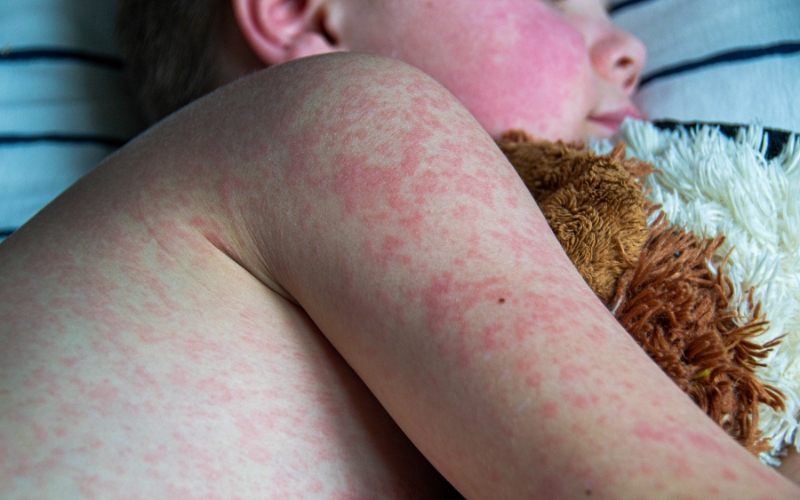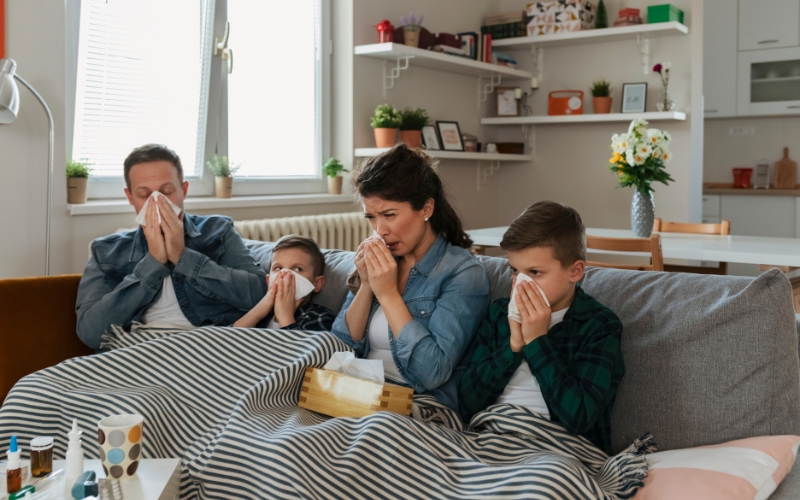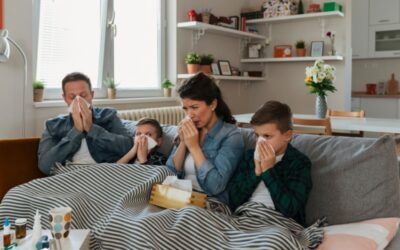Some people think of measles, a highly contagious viral infection, as just a little rash and fever that clears up in a few days. But measles can cause serious health complications, especially in children under 5 years old. If one person has it, as many as 9 out of 10 people nearby will become infected if they are not protected.1 It takes just one sick or exposed individual to trigger a cascade of measles cases!
Measles was declared eradicated in 2000;2 however, case counts continue to climb, with 2025 becoming the second-most active year for measles since 2000.
The Spread of Measles
This highly contagious viral infection spreads quickly. In an unvaccinated population, an individual with measles can often infect 12 to 18 other persons.3
Because measles can be transmitted through the air, an infected person can spread the virus by coughing, sneezing, talking, or even breathing. When patients with measles cough, sneeze, or speak, they release virus-containing respiratory droplets.
The measles virus (an enveloped virus) can land on surfaces and objects and remain suspended in the air for up to two hours. Because susceptible people can easily contract measles by touching a contaminated object or by inhaling the virus from the air and then touching their mouth, nose, or eyes, a person with measles can spread the disease to another person even after they have left the room. The Centers for Disease Control (CDC) states that if a person has measles, “up to 90% of the people close to you, who are not immune, will also become infected.” 4
Symptoms and Health Implications
Measles often starts with cold-like symptoms. After exposure to this highly contagious viral infection, measles symptoms usually begin to show up one to two weeks later. The most typical symptoms are:
- Rash (small red spots with blue-white centers)
- Cough
- Runny nose
- Red and watery eyes (conjunctivitis)
- High fever (up to 104° F)
- Fatigue
The rash, also called Koplik’s spots, typically appears 3 to 5 days after the initial symptoms, starting on the face and spreading. Koplik’s spots are a common symptom of measles that appear on the inside of the cheeks and are characterized by tiny, white dots with a reddish base.
Measles can cause serious consequences, including ear infections, diarrhea, pneumonia, and encephalitis, which can be fatal for children under five or people with compromised immune systems. Long-term measles can also result in “immune amnesia,” a condition in which the body loses the ability to fight off known infections, leaving people more vulnerable to subsequent diseases.5
Measles Protection
As with many infections, the best protection is prevention, and the measles vaccine offers the most effective prevention available. Introduced in 1963, the measles vaccine made a significant impact on the spread of this contagious disease. The CDC recommends two doses of the measles, mumps, and rubella (MMR) vaccine , which have been shown to be 97% effective in preventing infection. Most vaccinated individuals will be protected for life. Unvaccinated travelers who contract measles abroad each year are responsible for bringing the disease to the United States. While the majority of these tourists are Americans, occasionally, they come from other countries.6
Ideally, enough of the population gets vaccinated and becomes immune (i.e., unable to be infected or spread the disease), providing protection for those unable to be vaccinated, such as infants under 12 months or others with severely compromised immune systems. This phenomenon, called herd immunity, requires a minimum of 95% of the U.S. population to be vaccinated against measles. Cases to Date
Cases to Date
As of June 27, 2025, the U.S. continues to experience measles outbreaks, with a total of 1,214 confirmed cases reported across 36 jurisdictions and stated as follows:
Alaska, Arkansas, Arizona, California, Colorado, District of Columbia, Florida, Georgia, Hawaii, Illinois, Indiana, Iowa, Kansas, Kentucky, Louisiana, Maryland, Michigan,m Minnesota, Missouri, Montana, Nebraska, New Jersey, New Mexico, New York City, NY state, North Dakota, Ohio, Oklahoma, Pennsylvania, Rhode Island, South Dakota, Tennessee, Texas, Utah, Vermont, Virginia and Washington.
This is the 2nd highest annual case count in twenty-five years. Eighty-nine percent of these cases are associated with 23 outbreaks (outbreaks defined as three or more cases. A significant portion of cases are linked to a large outbreak in West Texas.
Severity of the cases are notable with 146 (12%) hospitalizations and three confirmed deaths. Many cases (95%) have been due to unvaccinated or unknown vaccinated patients.
How Synexis Can Help
Like the rest of the country, Synexis has been closely following the measles outbreaks.
As the sole developer of Dry Hydrogen Peroxide technology (DHP), Synexis continuously reduces pathogens, including enveloped viruses like measles, in the air AND on surfaces within occupied spaces.
Currently, DHP is deployed in numerous large health systems nationwide, educational centers such as dormitories and daycare centers as well as cruise ships, casinos, gyms, oil rigs and restaurants. DHP provides fully automated, 24/7/365 reduction of pathogens within occupied spaces. We have demonstrated efficacy across the continuum of healthcare, as shown in our 13 peer-reviewed studies. Meeting the rigorous, high-stakes standards within healthcare provides assurance to other industries.
To speak with an IAQ expert from Synexis, fill out this form and we’ll be in touch as soon as possible.
And to learn more about Synexis, click here.
References
- CDC Measles Complications. May 8, 2025 https://www.cdc.gov/measles/signs-symptoms/index.html
- History of Measles. May 8, 2025 https://www.mayoclinic.org/diseases-conditions/history-disease-outbreaks-vaccine-timeline/measles
- Guerra FM, Bolotin S, Lim G, Heffernan J, Deeks SL, Li Y, Crowcroft NS. The basic reproduction number (R0) of measles: a systematic review. Lancet Infect Dis. 2017 Dec;17(12):e420-e428. doi: 10.1016/S1473-3099(17)30307-9. Epub 2017 Jul 27. PMID: 28757186
- How Measles Spread. April 18, 2025. https://www.cdc.gov/measles/causes/index.html
- Pandey, Abhishek et al. Exacerbation of measles. Lancet Global Health. 2023 April; Volume 11, Issue 4, e478 – e479
- CDC Measles Vaccination May 12, 2025 https://www.cdc.gov/measles/vaccines/index.html







